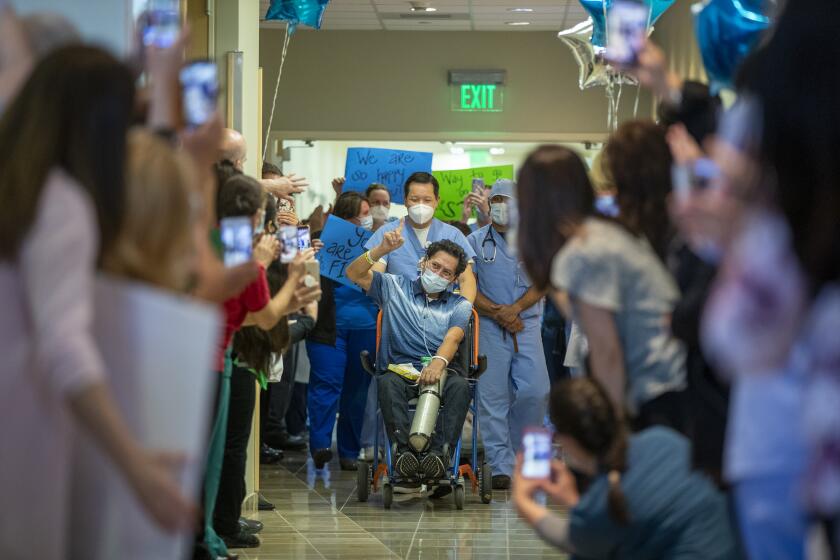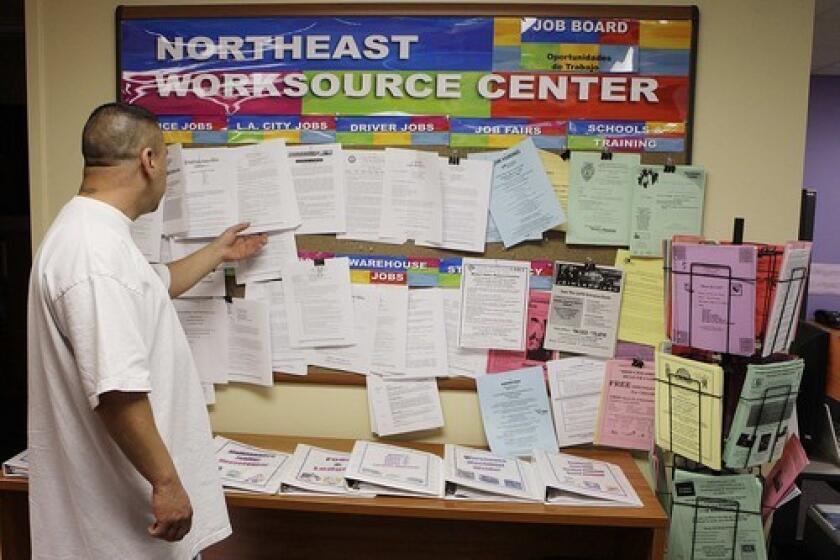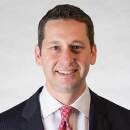Can Trump reopen the economy on May 1? Not really

- Share via
WASHINGTON — President Trump says he hopes to be able to begin reopening the nation’s shuttered economy on May 1. But ultimately, nervous governors, mayors, school boards and families across the country will determine when to resume normal life.
With more Americans out of work than at any time since the Depression in the 1930s, Trump is eager to ease the stay-at-home guidance he issued on March 16 and later extended through April 30 in an effort to contain the COVID-19 pandemic.
The president and his top economic advisors have floated plans to restart economic activity in phases, with some regions given greater leeway than others. Privately, White House officials concede the approach will have little effect on the larger economy, but hope to at least let some small businesses begin bringing back employees.
Speaking at the White House, Trump said he would consider the advice of his public health advisors, who have urged caution in lifting restrictions too quickly. Outside public health experts say another month or more may be necessary to keep the U.S. death toll from the coronavirus under 100,000.
“I’m going to have to make a decision, and I hope to God it’s the right decision,” Trump said Friday. “I would say without question it’s the biggest decision I’ve ever had to make.”
Asked what metrics he would use in deciding, Trump pointed to his head.
These are some of the unusual new scenes across the Southland during the coronavirus outbreak.
Trump also said he would probably include governors from both parties in a council to advise him on the issue and hinted that California Gov. Gavin Newsom may be among them.
The president wields tremendous influence over the national response to the pandemic, and many local and state leaders, especially fellow Republicans, would weigh his advisories heavily in deciding their own policy.
Although Trump asserted Friday that he has “absolute authority” to order the country open, the guidelines are not mandatory but recommendations.
Governors, mayors and business owners have the ultimate power. Many issued their own guidance before Trump did, and some already have announced plans to restrict commerce and public gatherings beyond May 1 no matter what Trump recommends.
At least 16 states — and numerous individual school districts — have closed schools at least until the summer, with more expected to follow, increasing pressure on business owners to remain closed or allow parents to continue working from home.
“When this started, the private sector basically shut the economy down before Trump told them to,” said Justin Wolfers, a professor of economics and public policy at the University of Michigan.
California’s unemployment rate will register double digits through 2021 and may be as high as 8.5% two years from now, UCLA economists predict.
“It turned out that what the federal government did was not very relevant — the government can’t force you to take risks you don’t want to take,” he added. “It couldn’t on the way down and it also can’t on the way up.”
Administration officials acknowledge that even their most optimistic plans would not open the entire country at once. And while corporate leaders are eager to reopen, polls show an overwhelming majority of Americans accept the restrictions because they appear to be working.
“Some places will be able to think about opening on May 1; most of the country will not, to be honest with you,” Surgeon General Jerome Adams told Fox News on Friday. “That’s how we’ll reopen the country. Place by place, bit by bit, based on the data.”
New York City, the nation’s economic capital and the area hit hardest by the pandemic, is expected to stay under a virtual shutdown until at least June 1, Mayor Bill de Blasio, a Democrat, told a news conference Thursday.
Newsom, a Democrat, has declared that California will chart its own course, relying less on the White House and leveraging its considerable economic power as “a nation-state.”
Newsom was the first governor to issue a formal stay-at-home order, on March 19, a step credited with preventing the type of spread that overwhelmed New York. Los Angeles County officials on Friday extended stay-at-home orders through at least May 15.
Governors in 42 states, comprising the vast majority of the U.S. population, have issued stay-at-home orders. Mayors in some of the other eight states issued their own restrictions.
“Governors and mayors have had to make the tough decisions that Washington has refused to make in terms of helping to manage the lives of the people we represent,” Michael Hancock, the mayor of Denver, said in an interview Friday. Though his office, like most mayoralties, is nonpartisan, Hancock is a Democrat.
“It wasn’t the president who decided to shut cities, schools, businesses down,” he added. “And it won’t be his call to get everyone back to work in terms of our states and our cities.”
Miami Mayor Francis Suarez, who tested positive for COVID-19 in March and recovered, issued restrictions for his city before Republican Gov. Ron DeSantis issued a mandatory stay-at-home order for the state that took effect April 3.
“Opening up prematurely could be problematic, and create a reinfection of our community,” Suarez, a Republican, said in an interview.
Californians out of work under the coronavirus stay-at-home order complain of making dozens of calls to the Employment Development Department.
Boston Mayor Martin Walsh, a Democrat, said his city had 310 new cases Thursday, its most yet, and chided Trump for what he called dangerous mixed messages.
“Any elected official right now talking about reopening publicly is, my opinion, doing a disservice to their community,” he said. “This is a virus. It’s unpredictable. It doesn’t have an end date on it.”
Public health officials say the nation needs not only more testing, but also a better network of workers trained to trace people who have the virus so they can isolate their contacts, as other countries have done.
Pulling back from a nationwide system of social distancing too soon could spur new hot spots.
“The big challenge is that [state and local] borders are porous, no matter how much we talk about lockdowns,” said Jeffrey Levi, a public health expert at George Washington University in Washington, D.C.
Some business owners plan to reopen slowly but will take their lead from local and state officials, rather than Trump.
Stephen Loftis, vice president of Firebirds Wood Fired Grill, based in Charlotte, N.C., said the chain’s 51 restaurants in 19 states followed local guidelines in ending dine-in service. When sit-down service resumes, the chain plans to offer fewer menu options and reduced seating capacities to protect customers and servers.
“We’re anxious to get back to some sort of normalcy as everyone is,” Loftis said. “The safety of our team members and our guests is paramount.”
Even if officials give more businesses the OK, it will not be easy for all of them to retrofit operations to satisfy safety requirements or get the products they need, given supply chain disruptions.
Mike Brzoska, who runs an aerospace supply company outside Detroit, was allowed to stay open as an essential manufacturer. But he now does temperature checks on employees and supplies isopropyl alcohol to rub down hands and equipment.
When a shipment of protective masks was stolen, he bought a 3-D printer and a set of filters to make his own. But he still feels at risk.
“I’m 60 and I smoke, so it’s got me worried,” Brzoska said.
More to Read
Get the L.A. Times Politics newsletter
Deeply reported insights into legislation, politics and policy from Sacramento, Washington and beyond. In your inbox twice per week.
You may occasionally receive promotional content from the Los Angeles Times.

![INGLEWOOD, CA - APRIL 10: Jacob De Wilde [sic], Local 33, left, and Lesli Lytle, right, Local 44, of International Alliance of Theatrical Stage Employees, loads a car with food at a food distribution organized to celebrate Good Friday, in collaboration with the Los Angeles County Federation of Labor, the Forum, the City of Inglewood, Labor Community Services and the Los Angeles Regional Food Bank, and other organizations host a food distribution for more than 5,000 families, or 20,000 individuals, impacted by the COVID-19 crisis.Inglewood, CA. (Irfan Khan / Los Angeles Times)](https://ca-times.brightspotcdn.com/dims4/default/b3cbe75/2147483647/strip/true/crop/2400x1600+0+0/resize/840x560!/quality/75/?url=https%3A%2F%2Fcalifornia-times-brightspot.s3.amazonaws.com%2F79%2F57%2Fb4fd719c4c9181aacec4e6508684%2Fla-photos-1staff-522870-me-0410-unions-food-distribution-009.IK.jpg)














